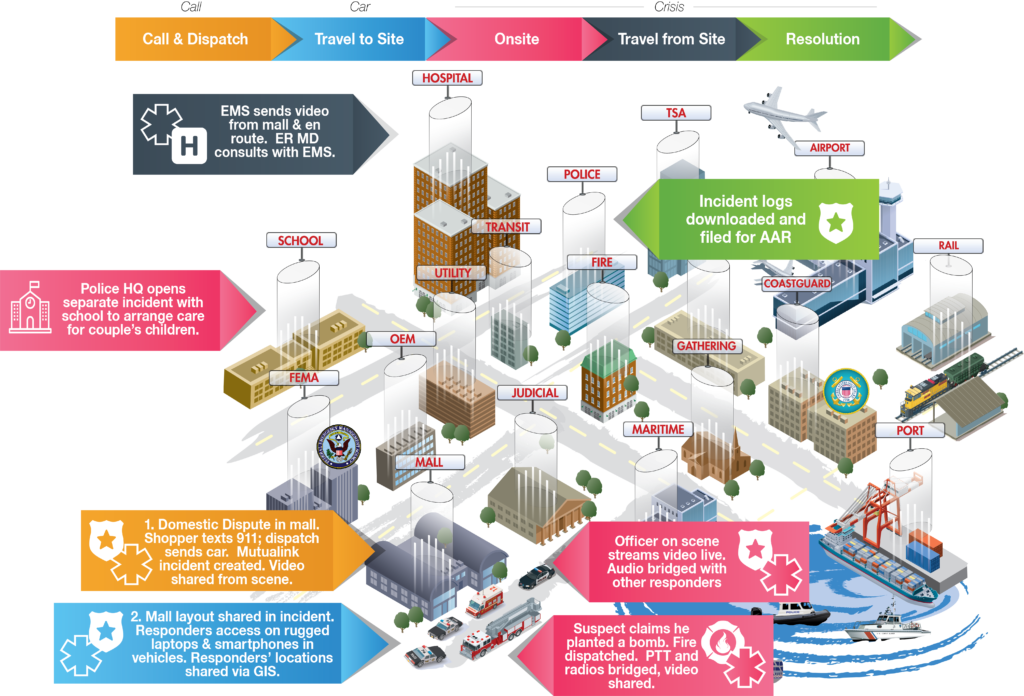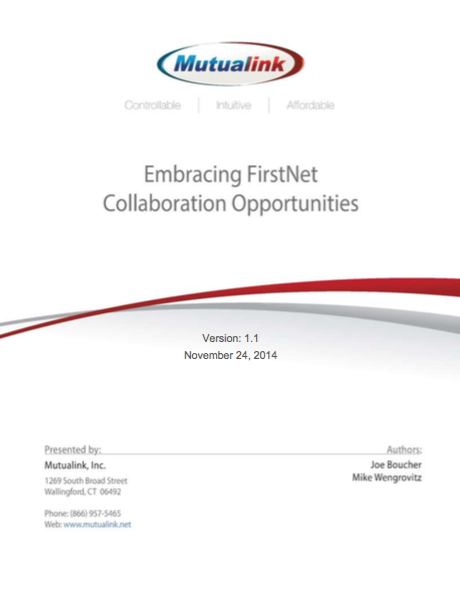Mutualink’s Role in the Public Safety Broadband Discussion
Evolving from a Narrowband Neighborhood to a Public Safety Broadband World

Leading the first responder transition from narrowband to public safety broadband by providing secure multimedia communications within and among agencies and organizations.
The need for mission critical group collaboration, both within and between otherwise siloed communication networks, is possible on an ad hoc basis using Mutualink’s interoperability platform.
WHITE PAPER
Lessons Learned from Global Attacks: How FirstNet Can Better Prepare the US for Crisis Response
Published: September 21, 2016
Terror attacks and mass shootings have become far too common in our world today, and public safety officials across the United States are forced to plan and prepare for worst-case scenarios in their own communities. As terrorist tactics continue to evolve, so too must the law enforcement response.
Patterns can be found in after-action analysis of incidents around the globe and here at home. Recurring problems hindering law enforcement include communication breakdowns among responding agencies, overcrowded cellular networks, and a lack of real-time information sharing at the scene of the attacks.
Our nation has an opportunity to incorporate lessons learned from crises worldwide into the ongoing development and deployment of the FirstNet (First Responder Network Authority) nationwide public safety broadband network (NPSBN). Established to modernize communications for first responders and provide a dedicated high-speed broadband network exclusively for public safety, FirstNet can make significant strides toward better preparing and equipping U.S. first responders for large-scale emergency scenarios.
What First Responders Really Need from Public Safety Broadband
Interoperability without giving up control
Distributed architecture enables Mission Critical Group Collaboration while maintaining the sovereignty of each agency.
Ad hoc Sharing Model
Sharing groups are formed dynamically in an ad hoc environment where media/data to share is securely pushed to the group by authorized users.
Always-available Interoperability
Deployed in Mobile Communications Units (MCUs) and LTE deployables as well as fixed infrastructure, cross-agency interoperability is available even when the wide-area network is not.
Mutualink: Proven in Early Public Safety Broadband Projects
Mutualink participated in Early Builder projects and Band 14 test deployments. Below are some projects and deployments for which Mutualink delivered Mission Critical Group Collaboration capability.
FirstNet Whitepaper
A fundamental goal of the First Responder Network Authority (FirstNet) is to enable multimedia communication and collaboration capability between all first responder agencies. As envisioned under the National Response Framework (NRF) and National Emergency Communications Plan (NECP), a scalable “all hazards, all disciplines” response capability should be implemented at all levels to enhance emergency response and recovery. This desired capability also extends to Critical Infrastructure and Key Resources (CIKR) throughout all identified sectors of a community under the National Infrastructure Protection Plan (NIPP). Furthermore, to capitalize on agencies’ existing investments, this capability should be inclusive of existing communication and collaboration systems.
Mutualink’s Mission Critical Group Collaboration
Group communications is a fundamental and critical need for first responders. We offer the Mission Critical Group Collaboration application (MCGC) to bring the next generation capabilities of the NPSBN to group communications. MCGC is a full multimedia platform that enables both intra-agency and cross-agency group communications to include voice, video, text messages, file sharing, and location sharing.
Communication silos, while necessary for a variety of reasons, create obstacles to group collaboration. Mutualink respects these silos, while enabling ad hoc group communication between and among otherwise siloed agencies and networks. With Mutualink, agencies on public safety broadband can collaborate with agencies and organizations on commercial broadband when the need arises.


